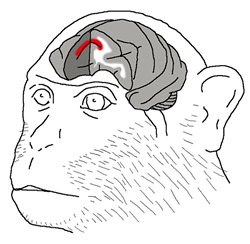
First, a monkey was shown a visual stimulus accompanied by a drop of water to teach the monkey which stimulus would indicate correct response (a visual block) in the following block. Then, when a small red square was shown on the monitor screen, the monkey pressed either the right or left lever. For the correct action, the visual stimulus that had been shown in the visual block was given as a feedback signal indicating correct lever choice; for an incorrect action, another stimulus was given as a feedback signal indicating incorrect lever choice. The monkey learned to correctly press the levers on the basis of these feedback signals indicating correct/incorrect choices. When the monkey consecutively repeated the correct action three or more times, it was taught another visual stimulus indicating correct lever choice and made to relearn which lever was the correct one to press.

The area from which the neuronal activity was recorded is indicated in red. In order to make the area visible, a part of the left frontal lobe is removed in the figure.

Above are examples of the two types of neurons recorded from the medial prefrontal cortex. The red line indicates the neuronal responses to the feedback signal following correct action, and the blue line indicates the responses to the feedback signal following incorrect action. Each raw of the black dots indicate the firings for each trial. The trial sequence following an accidental correct response and that following an accidental incorrect response are separately shown. In both cases, only the trial sequences that included no incorrect trials in the second or subsequent trials are shown. The two thin vertical lines on each graph indicate the onset and offset of the feedback signal.
In order to flexibly adapt to our environment, we first perform actions, judge whether or not those actions are appropriate or inappropriate, and from this learn to select appropriate behavior. Studies so far have found that the function of the frontal cortex of the brain, particularly a region of the brain called the prefrontal cortex located immediately behind the forehead, is important for flexibility in behavior. In addition, external measurements (fMRI, electroencephalography) of brain activity have shown that the medial prefrontal cortex is strongly activated when an executed action is incorrect. However, these studies have a lower resolution than a 1 mm square in which many neurons should be included. Therefore, the activity of neurons that respond to correct behavior might be hidden by the more prominent activity of neurons that respond to incorrect behavior.
We showed visual feedback signals that told a monkey correctness of an executed action, so that it could learn correct action selection. We studied how the individual neurons in the medial prefrontal cortex responded to the feedback signals. In an action learning task (Fig. 1) for our monkeys, following a go sign on a monitor the monkey was required to choose either the right or left lever, predicting whether it was correct or incorrect. If the choice was correct, the monkey was shown a visual stimulus which was taught in advance as a positive feedback signal; when incorrect, another visual stimulus was shown to the monkey as a negative feedback signal. The percentage of correct responses for the first lever choice was 50%. However, based on its first lever choice and the corresponding feedback signal indicating correct/incorrect responses, the monkey learned which lever press was correct, and obtained a correct response percentage of 90% or higher in subsequent choices. After three to four consecutive correct lever choices, the correct lever was randomly reset and the monkey made to learn once again which lever press was correct.
While the monkey was performing the task, an electrode was inserted into the medial prefrontal cortex (Fig. 2) to examine the activity of single neurons when a correct/incorrect feedback signal was presented. We found that two types of neurons existed: those which strongly responded to the feedback signal indicating correct lever choice (left, Fig. 3) and those which strongly responded to the feedback signal indicating incorrect lever choice (right, Fig. 3) . In addition, the responses to the feedback signals of these neurons were prominent during the trial immediately following a correct lever was reset (the monkey was unaware of whether its action was correct or not until after the sign appeared) , whereas for subsequent trials the responses decreased as the selected action was recognized to be correct before a feedback signal was given. These findings suggest that the medial prefrontal cortex distinguishes between correct and incorrect feedback signals and, furthermore, develops the learning of correct action selection based on each signal.
These findings provide the neural basis of significance of evaluation (whether an action is correct or not) in education, and may provide vital insight into considerations of how to maximize educational efficiency through optimal action evaluation.





